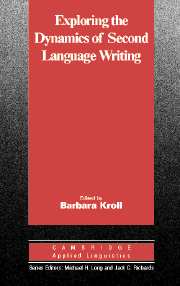Book contents
- Frontmatter
- Contents
- List of contributors
- Acknowledgments
- List of abbreviations used
- Series editors' preface
- Introduction: Teaching the next generation of second language writers
- I EXPLORING THE FIELD OF SECOND LANGUAGE WRITING
- II EXPLORING THE VOICES OF KEY STAKEHOLDERS:TEACHERS AND STUDENTS
- III EXPLORING WRITERS' FINISHED TEXTS
- IV EXPLORING CONTEXTUALITIES OF TEXTS
- V EXPLORING TECHNOLOGY
- EPILOGUE: EXPLORING OURSELVES
- Index
I - EXPLORING THE FIELD OF SECOND LANGUAGE WRITING
Published online by Cambridge University Press: 05 October 2012
- Frontmatter
- Contents
- List of contributors
- Acknowledgments
- List of abbreviations used
- Series editors' preface
- Introduction: Teaching the next generation of second language writers
- I EXPLORING THE FIELD OF SECOND LANGUAGE WRITING
- II EXPLORING THE VOICES OF KEY STAKEHOLDERS:TEACHERS AND STUDENTS
- III EXPLORING WRITERS' FINISHED TEXTS
- IV EXPLORING CONTEXTUALITIES OF TEXTS
- V EXPLORING TECHNOLOGY
- EPILOGUE: EXPLORING OURSELVES
- Index
Summary
When people set out to explore a previously unknown territory, they typically prepare themselves by studying maps and outfitting themselves with the needed regalia of exploration, such as specialized equipment and a compass. For territories already well explored, new visitors set out with a guidebook. So, too, a person newly drawn to a particular academic area should begin by preparing for his or her own exploration with the appropriate equipment or guidebook to provide some understanding of how the field has evolved and what to anticipate in the new terrain. What exactly should one expect to find in this field of study? What is central to the field? Where is the field moving? What is controversial? These are some of the questions that concern the authors of all the chapters in this volume.
Second language writing is a uniquely characterizable specialty area that has ties to but does not completely overlap with the fields of first language writing instruction, second language acquisition, or second language pedagogy. Perhaps a truism is that certain realities are true for all students in any academic environment whereas others are uniquely true for second language students. Just as linguists today recognize that language is culturally constructed, so too are students – defined by and defining their own place in the educational spectrum. This book is concerned with second language writers, bringing to the table not only their needs as novice writers but also their needs as second language speakers.
- Type
- Chapter
- Information
- Exploring the Dynamics of Second Language Writing , pp. 11 - 14Publisher: Cambridge University PressPrint publication year: 2003



